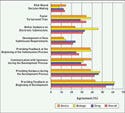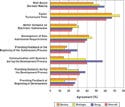FDA Review and Approval Not Fast Enough, Poll Finds
August 1, 2007
NEWS TRENDS
|
Figure 1. FDA's turnaround time: 35% of device respondents say it still needs improvement, but 65% also agree that it has improved over the last six years. |
It currently takes FDA far too long to review and approve products, according to several medical device companies. Nearly 60% of device companies that participated in a recent life sciences survey said the area where FDA could most improve is faster product turnaround time.
The survey, conducted by PricewaterhouseCoopers LLC (PWC; San Jose), serves as a report card on the working relationship between the life sciences industries and FDA. Responses were received from 66 companies, 21 of which were medical device manufacturers. The survey's authors hope that the report sparks more dialogue between industry and FDA on what changes need to be made on both sides. Providing industry with better guidance was cited as another area for improvement.
According to Tracy Lefteroff, a life sciences industry leader for PWC, the slow rate at which FDA reviews and approves products was the most glaring problem revealed in the report. “Both sides believe there's still a long way to go between industry and FDA to develop a more efficient and effective working relationship to cut down the review and approval times of medical devices,” says Lefteroff.
He explains that the delays could be partially due to the agency's staff shortages and turnover ratios. Six in 10 of the life sciences companies said that changes in FDA personnel have caused a break in continuity in at least one of their product reviews. More than half of the device companies also felt that changing a reviewer mid-review could “greatly influence” how products move through the development stage, as the change absorbs more time and resources.
|
Figure 2. (click to enlarge) According to the life sciences companies that participated in the survey, over the last six years, FDA has most improved in these areas. |
On the other hand, FDA's most improved area, from a device company perspective, is the feedback the agency provides at the beginning of product development. But this is often not carried through the total product life cycle.
When it comes to enhancing their relationship with the agency, the participating device companies have worked to build internal regulatory expertise, improve standard operating procedures, and implement better quality systems. They've also engaged in frequent communication with FDA during product development and have demonstrated knowledge of risk management programs.
|
Figure 3. (click to enlarge) According to the survey, FDA still needs the most improvement in these areas. |
The authors were surprised to learn, however, that only 38% of the device companies incorporate FDA feedback into the product development process. Ignoring FDA recommendations could increase the likelihood of delays later in the approval process, a point at which mistakes become more costly from the standpoint of time and resources,” the survey noted. Although this figure does not necessarily indicate what the entire device industry is doing, it points out where improvements may be needed.
The survey's statistics could give FDA and the device industry more insight into how to work together more effectively. “FDA has been receptive to getting feedback. This is an external survey that gives them validation rather than an internal one, which a lot of times doesn't tend to tell the whole story,” says Lefteroff. He adds that FDA has found the data valuable and might try to incorporate some of its points in future planning.
“The reality is that FDA is holding most of the cards where most of the improvement needs to take place,” says Lefteroff.
To conduct the survey, PWC also enlisted the help of BIOCOM.
Copyright ©2007 Medical Device & Diagnostic Industry
About the Author(s)
You May Also Like



.png?width=300&auto=webp&quality=80&disable=upscale)

